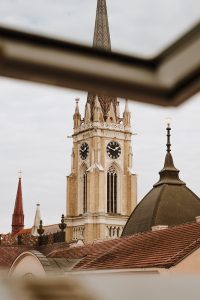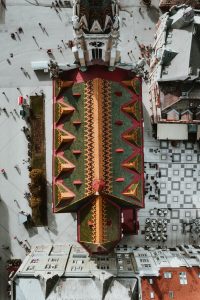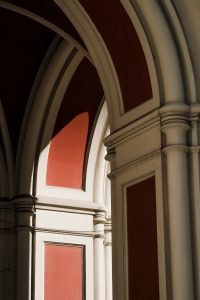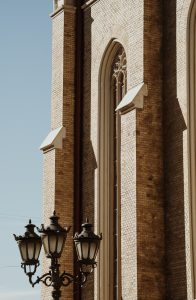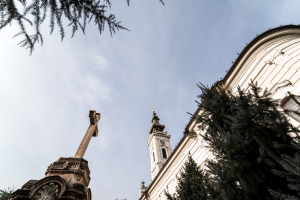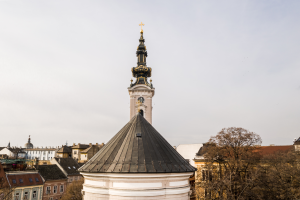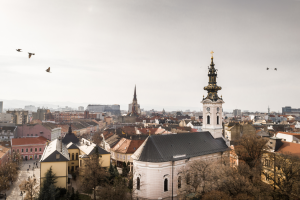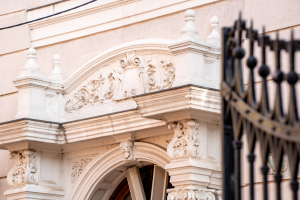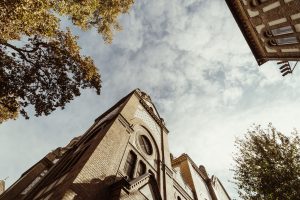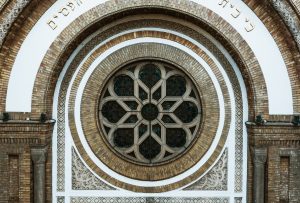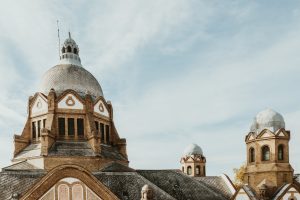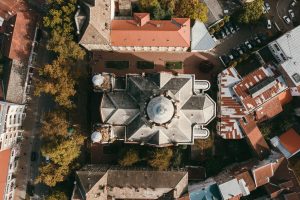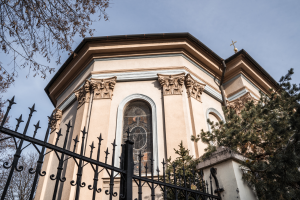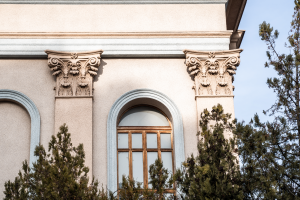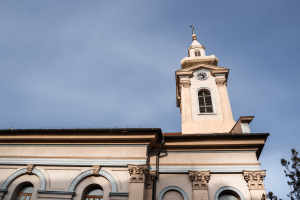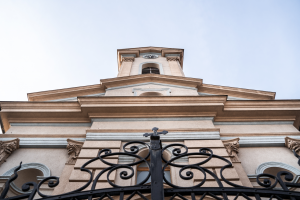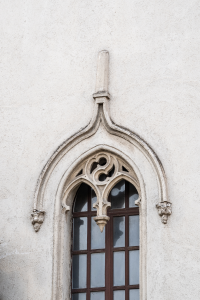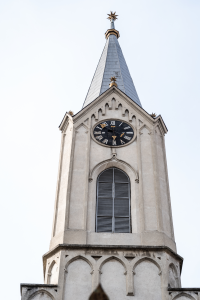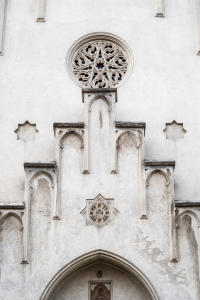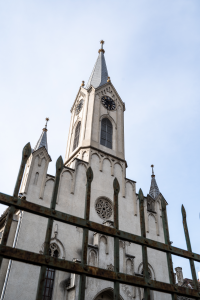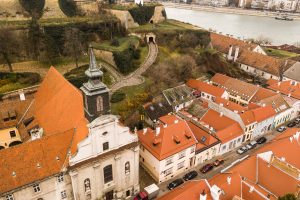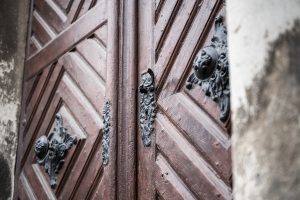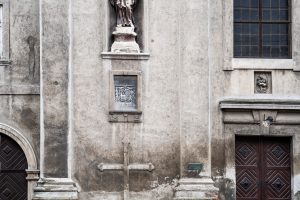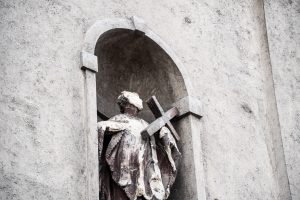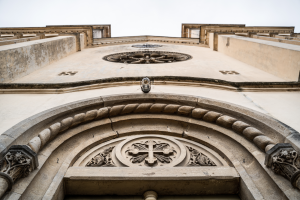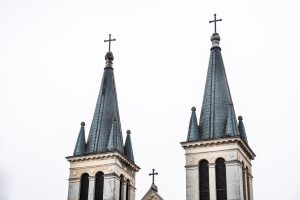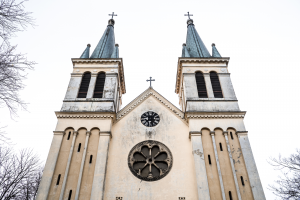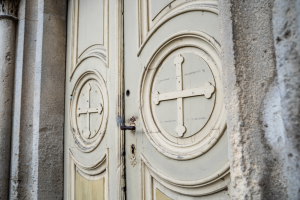Due to its unique geopolitical position, the area of Novi Sad has always been a meeting place for different peoples, religions and cultures. Hence, the image of the city is based on multiculturalism, while the spiritual life of the city has left numerous monuments of multi-confessionalism, both throughout Novi Sad and its surroundings.
Let us take you on a tour of the most interesting religious temples in Novi Sad. What’s even better is that you can visit all of them in one day – going on foot. Bundle up and get ready for a walk – let’s go!
The Novi Sad Cathedral
One of the symbols of Novi Sad is the Church of the Name of Mary, better known as the Novi Sad Cathedral, built at the end of the 19th century on the site of the much more modest Roman Catholic church from the 18th century, on the central Liberty Square. The church with a 72-meter-high tower was built in the Neo-Gothic style, based on the project of the architect György Molnár, and artists from Novi Sad, Budapest, Timişoara, Subotica, as well as Tyrol and Silesia worked on it. Interestingly, the residents of Novi Sad called it a cathedral out of respect, even though it is not – cathedrals are churches where the bishop’s seat is, and, in this case, the bishop resides in Subotica. It is also interesting that, although it serves as a meeting place for the majority of residents of Novi Sad, many have never been inside. Visit it during Catholic religious holidays – it is most beautiful then!
The Orthodox Cathedral Church of Saint George
The Orthodox Cathedral Church of St. George dates from the beginning of the 18th century, and it got its present appearance after the renovation at the beginning of the 20th century. It represents the most important Orthodox church in Novi Sad and the main episcopal church of the Diocese of Bačka. It is interesting that most of the icons are the work of the famous Serbian painter Paja Jovanović. The oldest public monument in Novi Sad, an Orthodox cross made of red marble dating from the second half of the 18th century, is in the churchyard. The monument was restored in 1867 by the benefactress Marija Trandafil. Originally located on the corner of Zmaj Jovina and Miletićeva streets, the cross has been in the gate of the Cathedral since 1957.
The Novi Sad Synagogue
At the end of Jevrejska Street, there is a former prayer temple, today’s music temple – the Novi Sad Synagogue. It was built in the period from 1906 to 1909 in the style of the Hungarian Art Nouveau. Today, the synagogue is not a prayer facility, but, due to its extraordinary acoustics, it serves to hold music events in it. There is an inscription in Hebrew at the entrance: ‘Ki beti, bet tefila ikara l’kol haamim’ (May this house be a house of prayer for all nations). It is one of the four synagogues in Serbia.
The Slovak Evangelical Church
The Evangelical Church in Novi Sad was built in 1886 by the Slovak community, which began to come to this area at the beginning of the 19th century. Slovaks were brought by Hungarian families and employed in service jobs, which is why Slovak evangelicals, as a poor community, completed the preparations for the construction of the church only at the end of the century. The church was built on the Senj market, the corner of Vuka Karadžića and Jovana Subotića streets today.
Reformed Christian Church
The Reformed Church, on the corner of Šafarikova and Pap Pavla streets, was built in 1865 on the site of a former hay market, after the first families of the Reformed-Calvinist religion moved to Novi Sad at the end of the 18th century and in the first two decades of the 19th century. The Reformed Christian Church has a seat in Feketić, and the believers are mostly Hungarians from Vojvodina. It is the work of the famous Novi Sad architect György Molnár, who also designed the Cathedral. The interesting thing about that building is that the Star of Bethlehem on the neo-Gothic bell tower of the church, is the only symbol on the entire building. There are no other sacral and religious symbols.
Ruthenian Greek Catholic Church
The Ruthenian Greek Catholic Church of the Holy Apostles Peter and Paul in Novi Sad is located on the corner of Jovana Subotića and Svetozara Miletića streets. It was built in the middle of the 19th century and was completely renovated at the end of the 20th century. During the renovation, it was given a golden cross, which motivated other religious communities to donate crosses to their churches. In its teaching, the church unites elements of both the Roman Catholic and Orthodox churches. According to many, this church is a true example of a unique Christian church from the time before the church schism in the 11th century.
Church of St. Juraj in Petrovaradin
The oldest church in Petrovaradin, the church with the Franciscan Monastery of St. Juraj, is located in the old baroque suburbium of the Petrovaradin Fortress, in Štrosmajerova Street. The church was built by the Jesuits after the departure of the Turks, and it is an extraordinary example of Baroque architecture, as well as one of the symbols of the so-called Gradić, i.e. the Suburbium of the Petrovaradin Fortress.
The church of Our Lady of the Snows at Tekije
The church of Our Lady of the Snows in Petrovaradin is a well-known ecumenical sanctuary, where Orthodox, Protestants and Catholics take part in processions on 5 August, in memory of the joint victory over the Turks in 1716, on the day of Our Lady of the Snows. According to tradition, this Christian temple dates back to the Middle Ages, and was destroyed by the Turks when they occupied these areas in the 16th century and built a mosque in its place. The church was renovated at the end of the 19th century in the Gothic style, and the altars were in the style of three Christian variants: Catholic, Orthodox and Protestant. On that occasion, a cross and a crescent were placed on the back of the dome, as a sign that this place of worship alternately belonged to two religions, Christian and Muslim. The church got its current appearance in 1976, when it was renovated again and today it is the largest Marian shrine in Serbia. The name comes from the Arabic word ‘tekija’, which means a peaceful resting place, usually next to roads or good water.
Armenian Church
Armenians came to Petrovaradinski Šanac from Belgrade in the first half of the 18th century with Greeks, Germans, Aromanians and some Arnauts. They mostly dealt with banking and built the former church, dedicated to Saints Peter and Paul, in 1746, on today’s Mihajlo Pupin Boulevard. In 1948, the last Armenian believer died, while the church was demolished during the expansion of the boulevard in 1963. All that is left of it is a monument (khachkar) built of stone of volcanic origin from Armenia, as well as a monumental marble tomb of the noble family Chenazy, famous and influential Armenians. The tomb was once located in the church gate and represents the only authentic Armenian monument in Novi Sad today.
In addition to the churches that make up the architectural pearls and religious symbols of the city, Novi Sad contains a whole series of smaller religious communities, which work and act in their prayer premises. Such is the Adventist Church in Petra Drapšina Street, as well as the Christian Nazarene Community in Valentina Vodnika Street. The Christian Baptist Church operates in Kolo Srpskih Sestara Street, while the Protestant Christian Community has its church on the Boulevard of Europe. Novi Sad also has the Mormon Church, while the Old Catholic Church dedicated to Anthony of Padua in Petrovaradin has meanwhile been adapted into an Orthodox church, the Church of the Intercession of the Most Holy Mother of God.
Although Novi Sad is rich in numerous religious buildings, most of them you will be able to admire exclusively – from the outside. Most prayer temples, especially of smaller religious communities, are almost always locked and open their doors to visitors only during major holidays or during celebrations.
Author: Bojana Kozomora
Photo: Jelena Ivanović

